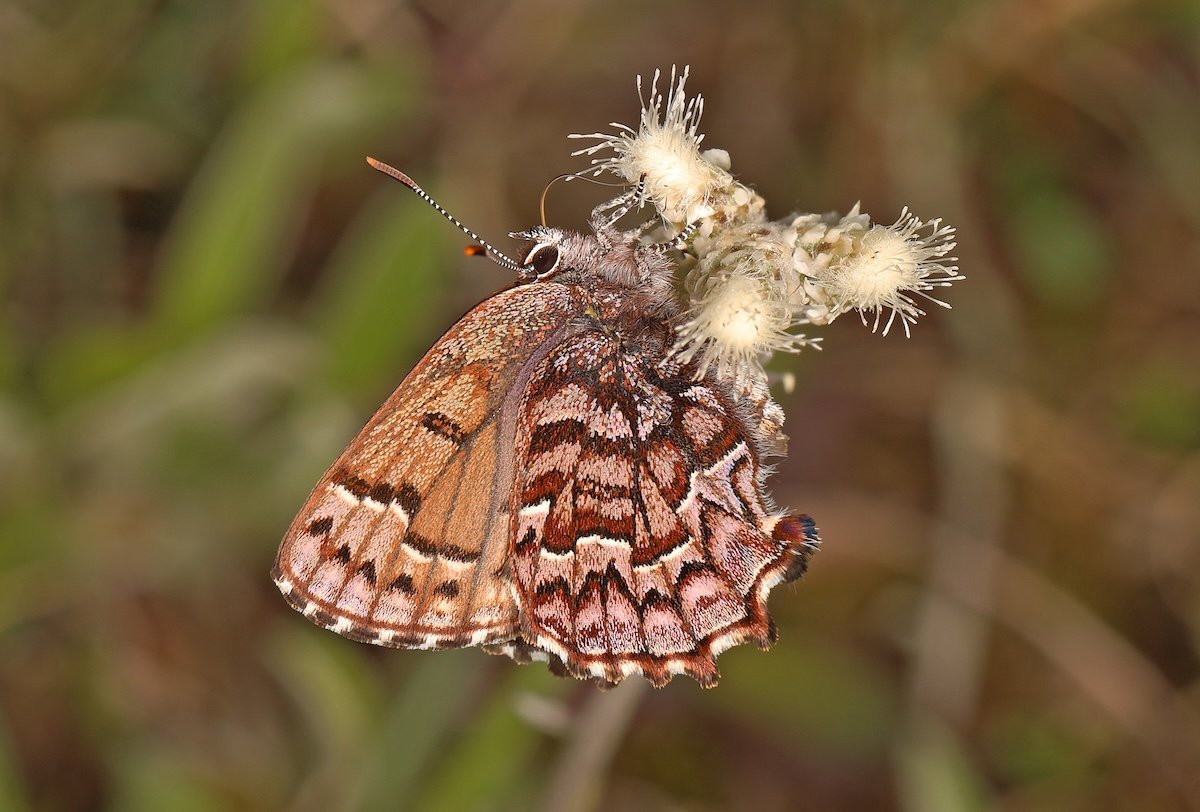Photo: Eastern Pine Elfin, Judy Gallagher
Judy Gallagher
May 2025
I look forward to spring's arrival each year, and particularly to the start of butterfly season. Elfins are among the first butterflies to emerge each spring. They are small with about a 1-inch wingspan, are furry looking, and have brown, gray and black markings. They look drab unless you look at them really closely. Elfins are part of a larger butterfly group called "hairstreaks," so named because of the fine, hair-like marking extending across the under surface of the hind wings. Elfins generally don't fly as fast as other butterflies, and they only have one brood, so you won't see them later in the year.
Eastern Pine Elfin, beautiful in its muted colors, Judy Gallagher
When not visiting flowers or moist soil, Eastern Pine Elfin males rest on pine foliage to await females. They are the only butterflies that use pine as a host plant. Early instar caterpillars eat pine needle sheaths and are the same reddish-brown color as the sheaths. Later instar caterpillars are green to match the pine needles that they feed on. The pupae overwinter in leaf litter beneath pine trees.
Eastern Pine Elfin showing its colorful scales, Judy Gallagher
Like other elfins, it looks brown and uninteresting until viewed closely. But look intently at its scales - there are reds, blues and greens in there, and the whole wing looks like it's gently washed with pink. This is a really hard butterfly to see intentionally. But examine flowers near pine woods, and you may be fortunate enough to see one.
Frosted Elfin, Judy Gallagher
Frosted Elfins are considered imperiled in Virginia, and we've only seen one once in our wildlife survey circle. Caterpillars feed on lupine and wild indigo flowers and developing seed pods, which are most common in habitats that are regularly burned, not a common environment in our area. The loose cocoons are found in the leaf litter at the base of the plants.
Henry's Elfin, Judy Gallagher
Henry's Elfin tends to be found in woods. There are at least six host plants for Henry's Elfin caterpillars, with American Holly being the preferred host species in our area. Henry's Elfins in the Piedmont feast on redbud. In other areas, caterpillars eat Persimmon, coastal holly species, blueberries and huckleberries and Maple-leaf Viburnum.
Henry's Elfin showing greenish color, Judy Gallagher
Henry's Elfins found near the northern edge of their range tend to be darker than southern individuals, and coastal Henry's Elfins often have strong green highlights. Males frequently perch during daylight hours, often just beyond the reach of my camera lens. The young caterpillars feed on buds (holly or redbud in our area) and young leaves. They pupate in about a month and overwinter in leaf litter.
While Henry's Elfins are pretty common, they aren't seen very often, partly because they are small and brown, and partly because they blend in well in the woods they frequent.
Other elfins found in Virginia are the Hoary Elfin and Brown Elfin, but they aren't common in our area.
Henry's Elfin soaking up the sun, Judy Gallagher
Macro photography of elfins is challenging. They are small and fly erratically, and they always seem to perch at an angle where I can't get the butterfly all in focus. As it turns out, there is a reason for this. These early season butterflies align themselves to soak up as much of the sun's rays as possible, which is why they are so rarely in a good position for me to take their picture.
Henry's Elfin with hairy eyeballs, Judy Gallagher
I was astonished when I took this picture and discovered that Henry's Elfin has hairy eyeballs. According to a study at Harvard University, several insect species have ocular hairs evenly spaced between the individual units of their compound eyes. Studies with wind tunnels show that the ocular hairs reduce airflow at the eye's surface and also reduce particle deposition without significantly reducing vision, much like our eyelashes protect our eyes. Nature never fails to delight me!
View more of Judy’s articles on A Closer Look: Nature All Around Us (formerly Observations from Meadowood).







